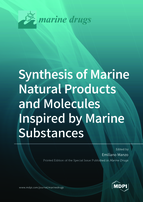Synthesis of Marine Natural Products and Molecules Inspired by Marine Substances
A special issue of Marine Drugs (ISSN 1660-3397). This special issue belongs to the section "Synthesis and Medicinal Chemistry of Marine Natural Products".
Deadline for manuscript submissions: closed (31 October 2020) | Viewed by 27048
Special Issue Editor
Interests: marine natural products; chemical synthesis; immunomodulatory molecules; drug discovery
Special Issues, Collections and Topics in MDPI journals
Special Issue Information
Dear Colleagues,
Marine natural products are characterized by high chemical diversity, biochemical specificity and other molecular properties that make them favorable as lead structures for drug discovery. In this field, one of the main problems is often the reduced natural availability of the isolated substances, which can complicate both the structural characterization and possible future developments. For these reasons, the study of bioactive marine metabolites should rely on the development of chemical synthesis and synthetic strategies aimed at preparation of pure compounds and analogs both for structural confirmation and/or for the large-scale preparation necessary for future applications.
Moreover, natural products can be a crucial starting point for the preparation of molecules structurally inspired by the latter, opening the way to new classes of biologically active compounds with pharmacological potential.
This Special Issue aims to collect original research articles regarding synthetic strategies for secondary marine metabolites and/or analogs that can favor applications of these molecules and/or can solve structural challenges common in the field of natural substances.
Dr. Emiliano ManzoGuest Editor
Manuscript Submission Information
Manuscripts should be submitted online at www.mdpi.com by registering and logging in to this website. Once you are registered, click here to go to the submission form. Manuscripts can be submitted until the deadline. All submissions that pass pre-check are peer-reviewed. Accepted papers will be published continuously in the journal (as soon as accepted) and will be listed together on the special issue website. Research articles, review articles as well as short communications are invited. For planned papers, a title and short abstract (about 100 words) can be sent to the Editorial Office for announcement on this website.
Submitted manuscripts should not have been published previously, nor be under consideration for publication elsewhere (except conference proceedings papers). All manuscripts are thoroughly refereed through a single-blind peer-review process. A guide for authors and other relevant information for submission of manuscripts is available on the Instructions for Authors page. Marine Drugs is an international peer-reviewed open access monthly journal published by MDPI.
Please visit the Instructions for Authors page before submitting a manuscript. The Article Processing Charge (APC) for publication in this open access journal is 2900 CHF (Swiss Francs). Submitted papers should be well formatted and use good English. Authors may use MDPI's English editing service prior to publication or during author revisions.
Keywords
- marine products
- synthesis
- drug discovery







